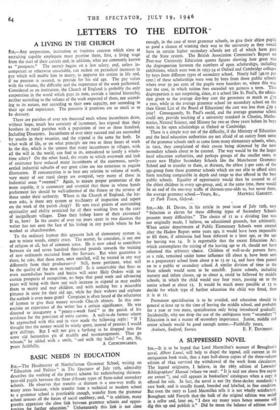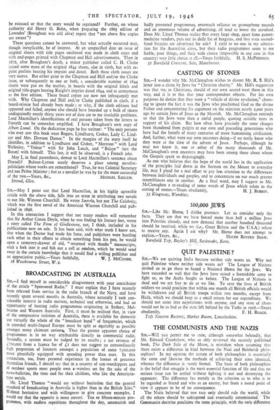A SUPPRESSED NOVEL
Snt,—It is to be hoped that Lord Macmillan's account of Brougham's novel, Albert Lunel, will help to dispel the legend, still current Jo the antiquarian book trade, that a bare half-dozen copies of the three-volume edition of 1844 survived the withdrawal of the work from circulation. The legend originates, I believe, in the 1865 edition of Lowndes' Bibliographers' Manual (where- we read: "It is said not above five copies are extant "), and still appears in booksellers' catalogues when a copy is offered for sale. In fact, the novel is not (by three-decker standards) a rare book, and is usually found, boarded and labelled, in fine condition. But even the story as Lord Macmillan tells it is not wholly satisfactory. Brougham told Forsyth that'the bulk of the original edition was sealed in a cellar and, later on'i " I dare say many years hence someone will dig this up and publish it." Did he mean the balance of edition would
be reissued or that the story would be reprinted? Further, on whose authority did Henry G. Bohn, when Preparing the 1865 edition of Lowndes' (Brougham was still alive) report that " not above five copies are extant "?
These questions cannot be answered, but what actually occurred may, though inexplicable, be of interest. At an unspecified date an issue of original sheets with title pages unaltered was made in cloth cases and with end-pages primed with Chapman and Hall advertisements. Then in 1872, after Brougham's death, a minor publisher called C. H. Clarke issued some more of the original 1844 sheets, also in cloth, but with re- print prelims bearing his imprint and dated. Both these cloth issues are very scarce. But either prior to the Chapman and Hall and/or the Clarke issue, or subsequently to one or both, a considerable number of 1844 sheets were put on the market, in boards with the original labels and original titlevages bearing Knight's imprint dated 1844, and as anonymous as the first edition. These board copies are now not infrequently met with. Why Chapman and Hall and/or Clarke published in cloth, if a board-reissue had already been made ; or why, if the cloth editions had appeared and failed, anyone else should have boarded up a bulk of sheets undisguisedly nearly thirty years out of date are to me insoluble problems. Lord Macmillan's identifications of real persons taken from the letters to Forsyth can be somewhat amplified. I have Brougham's own copy of Albert Lunel. On the dedication page he has written: " The only persons who ever saw this book were Rogers, Lyndhurst, Croker, Lady C. Lind- say and Mrs. Dawson Darner." In the margins of the story itself he identifies, in addition to Lyndhurst and Croker, " Mornton " with Lord Wellesley, " Velour " with Sir John Leach, and " Balaye " (not the Baron) with himself. This last, it will be observed, is a French joke. May I, in final parenthesis, demur to Lord Macmillan's sentence about Disraeli? Bulwer-Lytton surely deserves a place among novelist- politicians whose works are remembered? True, he was Colonial Secretary and not Prime Minister ; but as a novelist he was by far the more successful



























 Previous page
Previous page